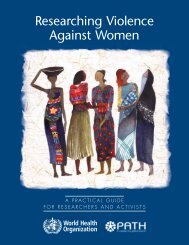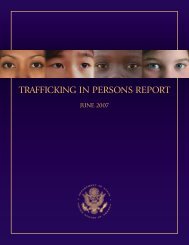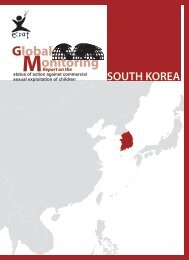Download PDF - Violence Against Children - East Asia and the ...
Download PDF - Violence Against Children - East Asia and the ...
Download PDF - Violence Against Children - East Asia and the ...
You also want an ePaper? Increase the reach of your titles
YUMPU automatically turns print PDFs into web optimized ePapers that Google loves.
Cambodia<br />
Responses were gained through both<br />
group discussion (25 group discussions<br />
involving 177 children), <strong>and</strong> individual<br />
interviews with 127 children to reduce<br />
<strong>the</strong> possible bias in group discussions<br />
where one member may dominate.<br />
3. A Community leaders survey was<br />
undertaken with members of <strong>the</strong> Village<br />
Development Committee in each<br />
location. Twelve committee members are<br />
elected from <strong>the</strong> community, each with a<br />
designated area of concern such as<br />
education or health for <strong>the</strong> village. They<br />
form a recognised authority, elect a village<br />
leader from <strong>the</strong>ir group, <strong>and</strong> link with <strong>the</strong><br />
next levels of government on matters of<br />
development <strong>and</strong> order.<br />
Each survey method involved an independent<br />
facilitator, recorder <strong>and</strong> an observer from <strong>the</strong><br />
Cambodian Centre for Advanced Study<br />
working in partnership with World Vision.<br />
The research showed that:<br />
• <strong>Children</strong> in communities where child rights<br />
or child-led activities were part of <strong>the</strong><br />
program showed greater independence<br />
<strong>and</strong> awareness of options than children<br />
where such activities were not part of <strong>the</strong><br />
program.<br />
• Equal access to school for girls is a concept<br />
which receives greater support in areas<br />
where children’s clubs/child rights have<br />
been promoted than in communities where<br />
this has not been <strong>the</strong> case.<br />
• <strong>Children</strong> in a village where a club operates<br />
are more likely to identify <strong>the</strong>mselves as<br />
having a role in caring for younger siblings<br />
than where <strong>the</strong>re are no children’s clubs.<br />
• Child rights promotion through clubs<br />
reduces support for <strong>the</strong> practice of<br />
children working at a young age to<br />
assist family income.<br />
• <strong>Children</strong> assume increasing leadership in<br />
activities that promote <strong>the</strong>ir ownership of<br />
<strong>the</strong> activity <strong>and</strong> <strong>the</strong>ir independence.<br />
• <strong>Children</strong>’s belief that <strong>the</strong>y can work<br />
toge<strong>the</strong>r is significantly encouraged when<br />
<strong>the</strong>y have opportunity to do so with <strong>the</strong><br />
support of <strong>the</strong> community.<br />
• Child-focused activities promote greater<br />
awareness of risks <strong>and</strong> of <strong>the</strong> importance of<br />
speaking out about abuse.<br />
• Communities where <strong>the</strong>re are child rights<br />
activities have greater awareness of <strong>the</strong><br />
issue of abuse, <strong>and</strong> some groups had taken<br />
action on problems children face.<br />
• Clubs offer structure for children to<br />
discuss, meet o<strong>the</strong>rs with similar concerns,<br />
<strong>and</strong> present <strong>the</strong>ir issues to <strong>the</strong> community.<br />
• The existence of clubs does not stop <strong>the</strong><br />
occurrence of child abuse or neglect in a<br />
community, but <strong>the</strong>y are a first stage<br />
towards giving children greater resources<br />
to plan <strong>and</strong> lobby. The presence of safe<br />
ga<strong>the</strong>ring places for children (clubs) also<br />
challenges <strong>the</strong> existing child protection<br />
concerns.<br />
• Child participation in structured activities<br />
informs <strong>and</strong> influences community leaders<br />
to give greater attention to issues placing<br />
children at risk.<br />
• Community leaders are more aware of<br />
avenues for local response if <strong>the</strong>re is an<br />
issue of child abuse in <strong>the</strong>ir village.<br />
• Child participation promotes an attitude<br />
among community leaders that not only<br />
considers <strong>the</strong> potential of children but also<br />
expresses concern on barriers <strong>the</strong>y<br />
encounter within <strong>the</strong> community. This is<br />
significant, as it is inside <strong>the</strong>ir area of<br />
control; <strong>the</strong>ir focus is more “what can we<br />
do”, whereas in community (D) <strong>the</strong><br />
attitude expressed was more externally<br />
focused on what o<strong>the</strong>rs would do.<br />
• Child participation activities <strong>and</strong> structure<br />
at village level has (to paraphrase Covey’s 19<br />
terms) increased children’s area of concern,<br />
which is an important step in increasing<br />
<strong>the</strong>ir sphere of influence.<br />
• Planned activities give community leaders<br />
greater appreciation of <strong>the</strong> link between<br />
issues of risk <strong>and</strong> <strong>the</strong> law.<br />
19 Covey, S R, The 7 Habits of Highly-Effective People, Simon & Schuster, New York, 1990<br />
36

















